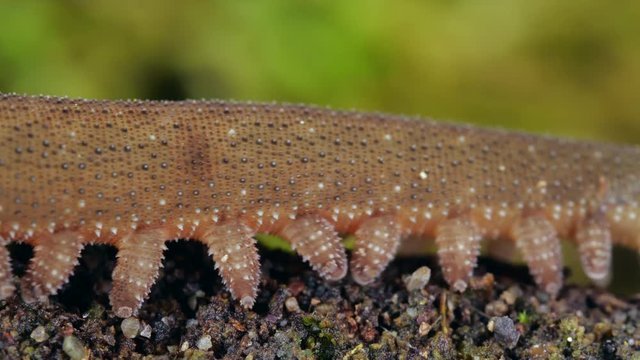
So, what’s the deal with velvet worms and their seasonal behavior? Honestly, it’s a mix of biology and a bit of ecology. These little guys, scientifically known as **Onychophora**, can be found in humid forests around the globe, where they navigate through leaf litter and underbrush. Changes in temperature, moisture, and food availability can all influence how these creatures behave as the seasons change. Let’s dig deeper into their wild world and discover how they thrive through different seasons.
Understanding Velvet Worms
Before diving into their seasonal behavior, it helps to know what velvet worms are all about. These creatures look like a cross between a caterpillar and a slug. Their bodies are covered in a soft, velvety texture, which is where they get their name. Velvet worms are part of a unique phylum that’s been around for millions of years, making them quite the ancient species.
Each velvet worm has around 13 to 43 pairs of legs, which they use for moving through their humid environments. They are nocturnal hunters, meaning they come out at night to hunt for food. Their diet mostly consists of soft-bodied insects and small invertebrates, which they catch using a sticky slime they produce. This gooey substance not only helps capture prey but also provides them with a way to defend themselves from predators, almost like a built-in security system.
Spring: A Time for Rebirth
As spring rolls around, the world awakens, and so do velvet worms. During this season, humidity levels start to rise, and temperatures become more favorable. It’s a fantastic time for velvet worms, as the increase in moisture means plenty of food availability. You might say it’s their version of a buffet!
Spring is also the breeding season for many velvet worms. Males often use chemical signals to attract females. After mating, females will lay eggs in a humid environment, ensuring their young have the best chance of survival. These eggs will hatch in the following months, so it’s crucial for the mother to find the right conditions.
You might wonder how they handle the increased competition for food. Here’s the thing: velvet worms are territorial, which means they often establish their own hunting grounds. This behavior helps lessen competition and ensures they can find enough meals during this bustling season.
Summer: The Heat is On
Summer can be a double-edged sword for velvet worms. On one hand, the warm weather makes their environment lively, but on the other hand, it can become too dry for comfort. During the hottest days, velvet worms might retreat to shaded spots beneath leaves or logs. They’re savvy little creatures, knowing when to hide out until conditions improve.
During summer nights, velvet worms are more active as they hunt for food. They have to be strategic about their movements, though, since the hotter temperatures can dehydrate them quickly. You can picture them like seasoned swimmers who know when to dive and when to float.
Another aspect of summer behavior involves their way of socializing (if you can call it that!). While these worms are primarily solitary, they sometimes gather in small groups when the conditions are just right, likely for mating purposes. This boost in social interaction is quite fascinating and adds a unique twist to their generally solitary lifestyle.
Fall: The Transition Season
As the heat of summer fades and temperatures begin to drop, velvet worms prepare for the cooler months ahead. Autumn is all about transition. During this time, these creatures might start to slow down. They typically become less active as nights get cooler and moisture levels decrease.
However, fall is also a vital time for growth. For the young velvet worms that hatched in spring, this is their chance to bulk up on nutrients before winter sets in. They’ll feast on insects that are still around, preparing themselves for the leaner months ahead.
One interesting behavior during fall is their adaptability. Velvet worms can sense changes in their environment, which makes them great at adjusting their habits. If it looks like winter’s going to be harsher than usual, they might seek out more sheltered spots to wait it out. It’s nature’s way of ensuring that they remain resilient despite changing circumstances.
Winter: The Struggle for Survival
Winter can be a tough time for velvet worms. With the cold setting in, many species will enter a sort of hibernation or dormancy. This means their metabolic rates slow down significantly, and they become downright lethargic. Picture them curled up in a cozy spot, preserving energy until warmer days arrive.
Finding food during winter is a challenge, as many of their typical prey sources are scarce. To cope, they rely on stored energy from the fall and may only venture out when the conditions are surprisingly warm or when there’s a thaw.
Some velvet worm species can survive this drought by staying deep in the leaf litter where it’s more humid and slightly warmer. It’s like having a winter home where they can ride out the storm until spring returns with its promise of new life.
Velvet worms, with their unique charm and fascinating behaviors, truly encapsulate the idea of adaptability in the wild. By adjusting their lifestyles to match the seasonal shifts, they demonstrate resilience that many of us can admire. It’s a cycle of life that reminds us how interconnected all creatures are with their environments.
The next time you’re wandering through a humid forest, take a moment to think of these remarkable beings. They may not steal the spotlight like butterflies or lions, but their unique seasonal behaviors and survival strategies tell a story worth sharing. Who knew that such tiny creatures could display such incredible tenacity? After all, in the grand tapestry of nature, every thread is important.
